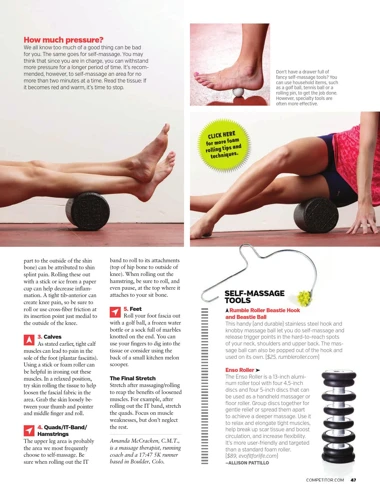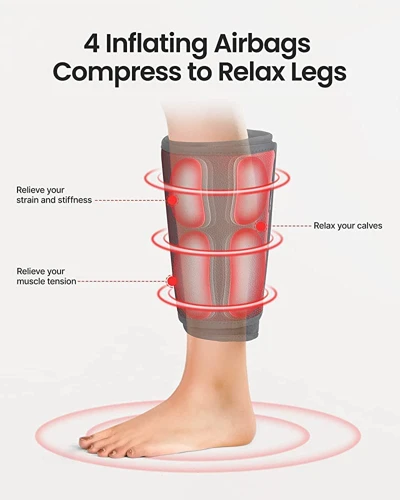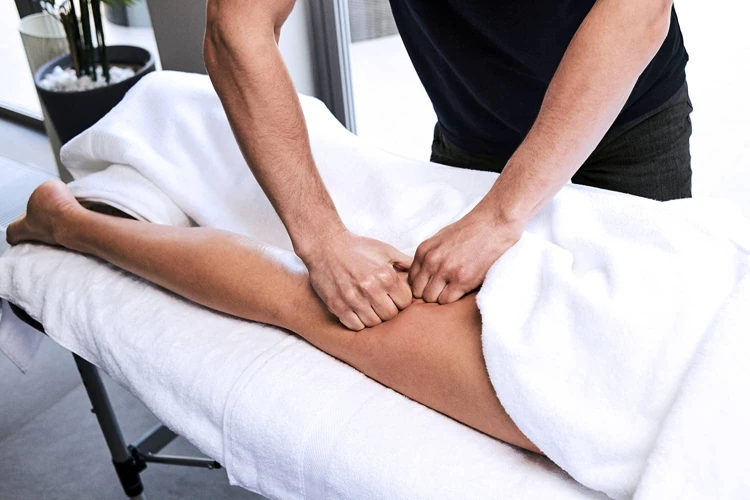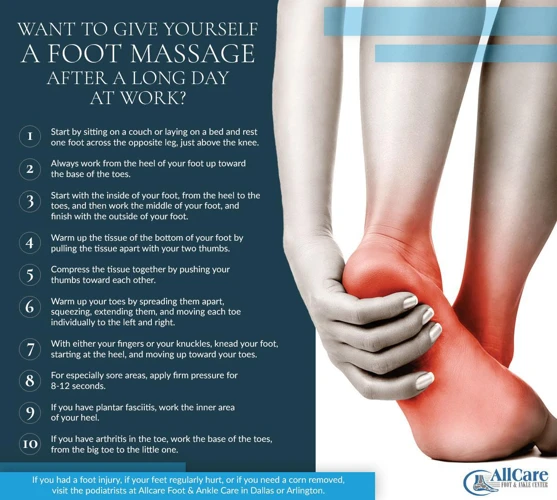If you are looking to learn how to massage your own calf, this step-by-step guide can help you reduce pain and soothe your calf muscles. Whether you are an athlete, someone with a physically demanding job, or just someone looking to relax after a long day, self-massaging your calf can be a great way to relieve tension and reduce pain. Follow this guide to learn how to massage your own calf and enjoy the benefits of self-massage.
Contents
Benefits of Massaging Your Calf Muscles

Improved Mobility
Massaging your calf muscles can help to improve your mobility by increasing flexibility and range of motion. This is due to the massage loosening tight muscles and tissues, allowing for a greater range of movement. Additionally, the pressure of massage helps to break up scar tissue, which can further improve mobility.
Reduced Muscle Pain
Massaging your calf muscles can help reduce muscle pain. This is due to the increased circulation that massage brings, which helps to release the build-up of lactic acid and other compounds that can cause pain. Additionally, massage can help to relax tense muscles, which can reduce the amount of pain felt.
Improved Circulation
Massaging your calf muscles can help to improve circulation. The pressure of massage helps to stimulate blood flow, which can help to reduce inflammation and improve nutrient delivery to the muscles. Improved circulation also helps to reduce pain and stiffness in the calf muscles.
By massaging your own calf muscles, you can enjoy the benefits of improved mobility, reduced muscle pain, and improved circulation. With regular massage, you can ensure your calf muscles remain healthy and strong.
Necessary Supplies

- Massage oil/lotion: This will help to reduce friction and make it easier to massage your calf.
- Towel: This will help to keep the area clean and provide a layer of protection.
- Footstool: This will help to give you better leverage when massaging your calf.
- Massage roller: This will help to target specific areas of your calf and apply pressure to relieve pain.
Step-by-Step Massage Instructions

Position Yourself
Sit comfortably in a chair and place one foot up on a stool. Make sure that your foot is stable and that it is at an angle that allows you to reach your calf easily. It may be helpful to use a towel to pad the surface of the stool for comfort.
Begin with Gentle Strokes
Using your fingertips, begin with gentle, broad strokes that move up and down the length of the calf muscle. Increase the pressure as needed, but be sure to remain mindful of your own comfort.
Deepen the Pressure
Continue with a deeper pressure, using the palms of your hands to massage the calf muscle in a circular motion. You may also move your hands in an up-down or side-to-side motion, depending on the desired pressure.
Apply Tissue Release Techniques
To further release tension, you can use a tissue release technique such as compression or stripping. To do this, use your thumb and index finger to compress and hold the muscle for several seconds. Then, use your other hand to strip the muscle in the same direction as the muscle fibers.
Perform Cross-Fiber Friction
Cross-fiber friction is a technique that can help break up adhesions and scar tissue in the muscle. To perform this, use your thumbs to apply pressure in a circular motion, moving down the calf muscle in a perpendicular direction to the muscle fibers.
Finish with a Gentle Massage
Finish the massage with gentle strokes that move up and down the muscle. Be sure to take note of any areas that feel tight and spend extra time on those areas. When you are finished, give your calf a gentle stretch to further relax the muscle.
Safety Precautions

Before massaging your calf, make sure to:
- Take off any jewelry that could get in the way of the massage.
- Wash your hands thoroughly to reduce the risk of infection.
- Apply a small amount of massage oil or lotion to reduce friction.
- Make sure the pressure you apply is comfortable and not too intense.
- Stop the massage immediately if you feel any pain.
After massaging your calf, make sure to:
- Clean the area with a warm, damp cloth.
- Drink plenty of water to help flush out toxins.
- Apply a cold compress to reduce any swelling.
- Rest for a few hours after the massage.
- Consult a doctor if you experience any pain, swelling, or redness.
Other Massage Techniques

- Effleurage Massage: This technique is a gentle stroking movement that is used to warm up the muscles and increase the circulation of blood. It is done by using the palms of your hands to move in a circular motion over the calf area.
- Friction Massage: This technique involves using the fingertips to press firmly into the calf muscles and then move in a circular motion. This helps to break down any muscle knots and increase circulation.
- Tapotement Massage: This technique involves lightly tapping on the calf muscles with the fingertips or cupped hands. This helps to stimulate the muscles and improve circulation.
- Vibration Massage: This massage technique uses a vibrating device to massage the calf muscles. The vibrations help to relax the muscles and reduce pain.
- Trigger Point Massage: This massage technique focuses on specific points in the muscles that are causing pain or discomfort. A massage therapist will apply pressure to these points to help reduce pain and tension.
Self-Care Tips
- Warm Up: Before beginning a massage, warm up your calf muscles by taking a few minutes to do light stretching. This will help relax the muscles and prepare them for the massage.
- Take Breaks: If you’re feeling pain during the massage, take a break to give your muscles a chance to rest. This will help prevent any further injury.
- Massage with Oil: Using a massage oil or lotion will help your hands glide more smoothly over the skin and reduce friction. Choose an oil or lotion that is specifically designed for massage.
- Be Gentle: It’s important to be gentle while giving yourself a massage. Applying too much pressure could cause more harm than good. Start with gentle strokes and gradually increase the pressure as needed.
- Listen to Your Body: If at any point during the massage you feel pain or discomfort, stop and take a break. If the pain doesn’t go away after a few minutes, seek medical advice.
- Drink Water: Drinking plenty of water before and after a massage will help your muscles recover faster. This will also help flush out any toxins that may have been released during the massage.
Frequently Asked Questions
What Kind of Massage is Best for Calf Muscles?
Deep tissue and myofascial release massage are the two best massage techniques for calf muscles. Deep tissue massage applies deep pressure to the muscles, helping to improve posture and reduce tension and pain. Myofascial release massage releases tightness and restrictions in the fascia, the connective tissue that surrounds the muscles, allowing for better mobility and range of motion. Both of these massage techniques can be beneficial for calf muscle pain and soreness.
Is it Safe to Massage Your Own Calf?
Yes, it is safe to massage your own calf. However, it is important to do so with gentle pressure and to be mindful of any pain or discomfort that may occur during the massage. If you feel any pain or soreness, stop the massage and seek medical attention. Additionally, it is important to warm up and stretch the calf muscles before massaging to prevent any further injury or discomfort.
How Often Should I Massage My Calf?
Massage your calf muscles at least three times a week for lasting relief from pain and discomfort. Increase the frequency if you experience tightness or soreness. Be sure to give each massage session at least 15 minutes for optimal results. After a few weeks of regular massage, you will begin to notice your muscles loosening and your pain decreasing.
What should I do if I experience pain during the massage?
- Stop the massage and take a break.
- Check for any areas of discomfort or tenderness.
- Identify the source of the pain.
- Reduce the pressure or intensity of the massage.
- Apply a cold compress to the area.
- Consider taking pain relief medication.
- Seek medical help if the pain persists.
If you experience pain during a massage, it is important to take a break and assess the situation. Check for any areas of discomfort or tenderness and identify the source of the pain. You may need to reduce the pressure or intensity of the massage. Applying a cold compress to the area may also help reduce any swelling or inflammation. If the pain persists, consider taking pain relief medication or seeking medical help.
Are there any special techniques I should use while massaging my calf?
Yes! Here are some techniques you can use to get the most out of your calf massage:
- Start with light, gentle strokes to warm up the muscle tissue before applying deeper pressure.
- Apply deep pressure using kneading and circular motions. This helps to release tension in the muscles.
- Use a tennis ball or foam roller to perform a self-massage on the calf muscles. Focus on areas that feel particularly tight.
- Use a rolling pin or golf ball to massage the entire length of the calf muscle.
- Use a massage stick or roller device to massage the calf muscles.
- Apply pressure points along the calf muscle to help relieve tension.
- Stretch the calf muscles after the massage to help improve flexibility.
Remember to always use slow, gentle motions when massaging your calf muscles to avoid injury. Massaging your calf muscles can help relieve pain, improve circulation, and reduce inflammation.
Conclusion
Massaging your own calf can be a great way to reduce pain and soothe your muscles. Follow the step-by-step guide to ensure that you are effectively and safely performing this self-massage. Remember to pay attention to the tender areas, apply gentle pressure, and use a variety of massage techniques to get the most out of the massage.

